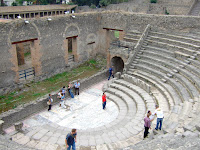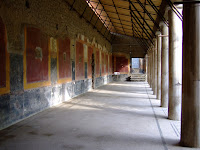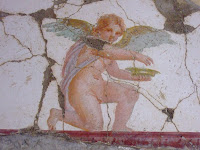 The weather forecast was for torrential rain after midday (it actually arrived about 5:30) so we decided on an early start for Pompeii. There were added benefits in that we could park easily and we beat most of the tourist hordes to the prime photo spots like the forum.
The weather forecast was for torrential rain after midday (it actually arrived about 5:30) so we decided on an early start for Pompeii. There were added benefits in that we could park easily and we beat most of the tourist hordes to the prime photo spots like the forum. [A side note for parking for anyone reading this and thinking of visiting: Don't be so focused on finding the front gate that you drive past the cheaper parks just outside the complex. We paid €2.50 per hour and the machine only accepted coins! As we left we passed €1/hr parks.]
[A side note for parking for anyone reading this and thinking of visiting: Don't be so focused on finding the front gate that you drive past the cheaper parks just outside the complex. We paid €2.50 per hour and the machine only accepted coins! As we left we passed €1/hr parks.] Pompeii is much, much larger site than Herculaneum and has a basilica, temples, forum, theatres, amphitheatre, and even a brothel, as well as the shops, homes and gardens. It also has many more tourists.
Pompeii is much, much larger site than Herculaneum and has a basilica, temples, forum, theatres, amphitheatre, and even a brothel, as well as the shops, homes and gardens. It also has many more tourists.  You can also see Vesuvius looming over the town as you walk along the city streets, a constant reminder of the reason why the ruins, and you, are there. The 'cityscapes' along the streets: shop-fronts, cart-tracks, food stalls, drinking fountains and so forth seemed to provide a much better insight into their life and times. To finally see the plaster casts made of the doomed inhabitants, that one learnt about in school is quite remarkable.
You can also see Vesuvius looming over the town as you walk along the city streets, a constant reminder of the reason why the ruins, and you, are there. The 'cityscapes' along the streets: shop-fronts, cart-tracks, food stalls, drinking fountains and so forth seemed to provide a much better insight into their life and times. To finally see the plaster casts made of the doomed inhabitants, that one learnt about in school is quite remarkable. However, while Herculaneum was much less popular with the tourists, to leave the tour parties well behind there are other sites to visit. We knew about them because they were included in the 5-site, three-day pass we purchased. A note of caution though, be sure you go equipped with a sat-nav system as the instructions given and the tourist brown signs are completely inadequate to
However, while Herculaneum was much less popular with the tourists, to leave the tour parties well behind there are other sites to visit. We knew about them because they were included in the 5-site, three-day pass we purchased. A note of caution though, be sure you go equipped with a sat-nav system as the instructions given and the tourist brown signs are completely inadequate to  find these other places.
find these other places.These other sites were palatial country residences, two of them on the escarpment overlooking the Bay of Naples. Their view, when occupied, was not spoiled by row upon row of cluttered high-density housing.
 These three villas, one of which belonged to Nero's second wife, show the amazing opulence of the high-class in Roman times, e.g. 67m long swimming pool, their own bath complexes - no tripping down to the public baths and mixing with the hoi-polloi for these folk. They were built around atria and had other indoor gardens as well. To bump into another tourist at these locations was a rarity.
These three villas, one of which belonged to Nero's second wife, show the amazing opulence of the high-class in Roman times, e.g. 67m long swimming pool, their own bath complexes - no tripping down to the public baths and mixing with the hoi-polloi for these folk. They were built around atria and had other indoor gardens as well. To bump into another tourist at these locations was a rarity.  They are: Villa Poppea, Oplontis; Villa Arianna & Villa San Marco, Stabia.
They are: Villa Poppea, Oplontis; Villa Arianna & Villa San Marco, Stabia.It is such a pity that the treasures from these sites have been 'looted' for museums around the world, centres hacked out of frescoes and mosaic floors to display in the Louvre or British Museum.
 One of the weather web sites consulted before our trip predicted "tons of rain" for Sunday; a very odd turn of phrase for a weather forecast. It seems the forecast was out by about 8 hours as at around 6:30 the heavens opened and "tons of rain" fell so that by 7:30 the street outside the hotel was a river with at least 6 inches of water rushing down to the sea. The sudden change in the weather was not entirely unexpected as, during our time at Pompeii,
One of the weather web sites consulted before our trip predicted "tons of rain" for Sunday; a very odd turn of phrase for a weather forecast. It seems the forecast was out by about 8 hours as at around 6:30 the heavens opened and "tons of rain" fell so that by 7:30 the street outside the hotel was a river with at least 6 inches of water rushing down to the sea. The sudden change in the weather was not entirely unexpected as, during our time at Pompeii,  we noticed that every time we opened our water bottles we could hear the air-pressure equalising, something we have previously only ever experienced after a flight. The barometric pressure must have been dropping quite dramatically to affect the water bottles like this, repeatedly, in such a short time span.
we noticed that every time we opened our water bottles we could hear the air-pressure equalising, something we have previously only ever experienced after a flight. The barometric pressure must have been dropping quite dramatically to affect the water bottles like this, repeatedly, in such a short time span.




No comments:
Post a Comment